Weekly Advanced Technologies〔84〕

Weekly Advanced Technologies〔84〕丨Shaping Crystals at the Atomic Level: Unveiling the Assembly-Final Form Connection; Revolutionary Terahertz Tri-Comb Laser Emerges — Redefining High-Speed Metrology Standards
Understanding how crystals evolve from minute nuclei into ordered structures has long been a central challenge in materials science. Recently, an international study revealed a coalescence growth mechanism influenced by crystal size, defect density, and contact modes at the atomic scale, providing new insights for the precision synthesis of crystalline materials. Meanwhile, while terahertz technology holds immense potential for precision measurements, the development of efficient sources has remained a bottleneck; a Chinese research team has now successfully developed a novel compact terahertz tri-comb source system, laying a crucial foundation for next-generation high-performance terahertz instruments.
Based on the weekly diary of technology provided by the daily list of the NCSTI online service platform, we launch the column "Weekly Advanced Technologies" at the hotlist of sci-tech innovation. Today, let's check out No.84.
1. JACS丨Shaping Crystals at the Atomic Level: Unveiling the Assembly-Final Form Connection
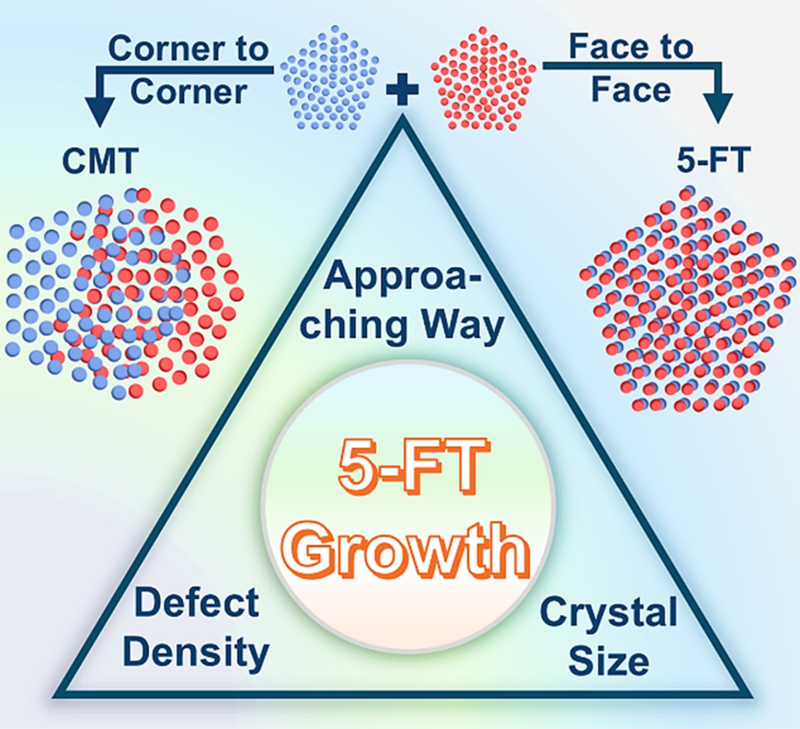
Multifactor Coupling in Crystal Fusion Growth: Effects of Size, Defect Density, and Contact Modes
Nucleation and growth are two critical stages in crystallization, playing pivotal roles in controlling crystal phase, size, morphology, and properties. However, classical theories have struggled to explain numerous phenomena observed during crystal growth, such as amorphous intermediate states and component segregation in secondary nucleation.
Researchers led by Professor LI Junjie from the Xinjiang Technical Institute of Physics and Chemistry, Chinese Academy of Sciences, collaborating with scientists from Lawrence Berkeley National Laboratory (USA) and the International Iberian Nanotechnology Laboratory (Europe), have revealed the fusion-growth mechanism of crystals governed jointly by crystal size, defect density, and contact modes at atomic scale. This breakthrough was achieved through spherical aberration-corrected transmission electron microscopy combined with molecular dynamics simulations.
Atomic-scale dynamics studies demonstrate that: when a fivefold twinned crystal meets a smaller nanocrystal, or when two fivefold twinned crystals contact face-to-face, rapid fusion occurs, forming a new fivefold twinned crystal. Conversely, when two crystals interact point-to-point at vertices, fusion dynamics become significantly slower, favoring complex multiple twinned structures over fivefold twinned crystals.
These results highlight how interfacial defects and nanocrystal contact modes govern fusion pathways. Furthermore, the study uncovers a curved grain boundary formation mechanism driven by atom column migration along defect sites.
By in situ observation of crystallization dynamics, this work elucidates fusion mechanisms of fivefold twinned crystals, providing critical guidance for controllable crystal preparation.
2. Laser & Photonics Reviews丨Revolutionary Terahertz Tri-Comb Laser Emerges — Redefining High-Speed Metrology Standards
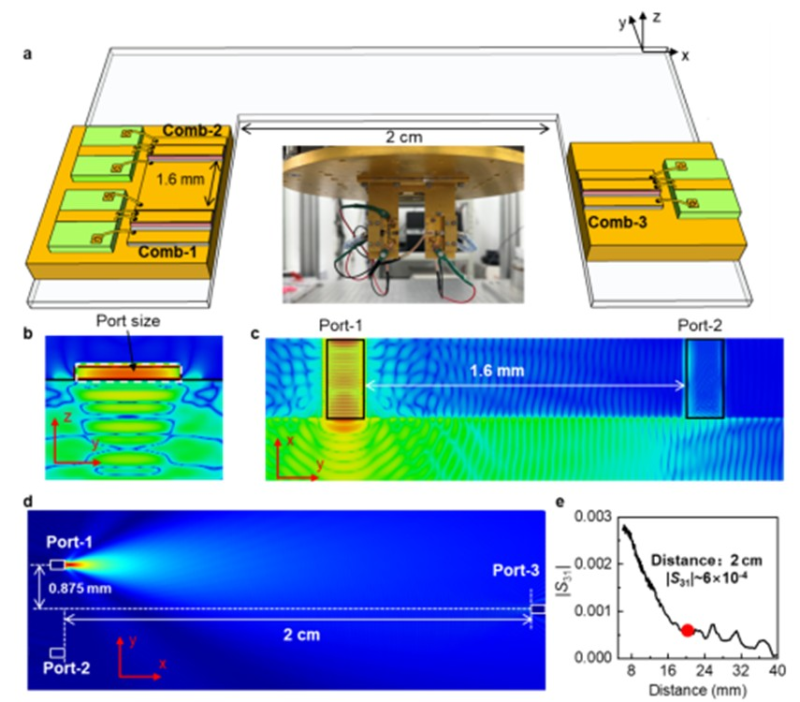
The System Schematic of Terahertz Tri-Comb Laser and Finite Element Analysis Simulation Process
Researchers led by Prof. Li Hua from the Shanghai Institute of Microsystem and Information Technology, Chinese Academy of Sciences, in collaboration with Prof. ZENG Heping's team at East China Normal University, have achieved a significant breakthrough in terahertz triple-comb sources. The study proposed and realized a compact terahertz triple-comb system comprising: Two on-chip integrated terahertz quantum cascade laser (QCL) frequency combs (designated Comb-1 and Comb-2). One external single-comb device (Comb-3). This configuration combines integration advantages with operational flexibility, resulting in enhanced thermal stability and superior data acquisition capability compared to conventional dual-comb systems.
Through self-detection technology, the system has acquired terahertz triple-comb signals generated by arbitrary pairwise mixing of frequency combs. The team has employed 3D and 2D finite element simulations to reveal inter-comb coupling mechanisms where Comb-1 and Comb-2 couple via substrate while Comb-3 primarily couples through free-space. Experimental results have demonstrated that the system generates stable triple-comb signals containing 11 comb teeth with >30 dB signal-to-noise ratio (SNR) and features flexible spectral detection capabilities, enabling synchronous acquisition of multiple dual-comb RF spectra such as simultaneously capturing Dual-Comb 13 and Dual-Comb 23 spectra when utilizing Comb-3 as a rapid detector. Phase noise analysis has confirmed superior system stability, and this breakthrough has provided a high-performance source solution for terahertz spectroscopy and precision metrology, significantly advancing multi-comb terahertz technologies.
3. Physical Review Letters丨Quark Splitting Decoded: Precision Exploration of Matter's Ultimate Constituents
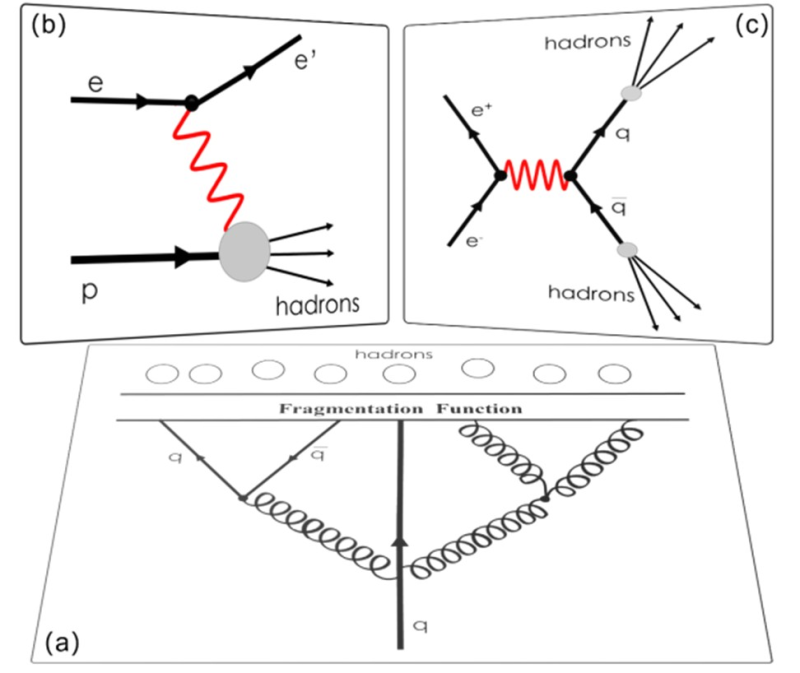
(a) Diagram of parton fragmentation into hadrons
(b) Diagram of semi-inclusive deep inelastic electron-proton scattering
(c) Diagram of electron-positron annihilation process
Joint teams including the Institute of Modern Physics of the Chinese Academy of Sciences, the School of Physics and Astronomy at Shanghai Jiao Tong University, and the Institute of Quantum Matter at South China Normal University have reported significant progress in the study of parton fragmentation functions. This research has, for the first time at the to-date highest theoretical precision, revealed key mechanisms of quark fragmentation processes into charged hadrons such as π± and K±, providing new perspectives for understanding the microscopic structure of matter and strong interaction mechanisms.
Parton fragmentation functions describe the process by which high-energy quarks and gluons transform into observable hadrons, and serve as the cornerstone for understanding color confinement and hadronization phenomena in quantum chromodynamics (QCD). However, due to their non-perturbative nature, these functions cannot be directly computed theoretically and require global analysis of experimental data. By leveraging electron-positron annihilation and semi-inclusive deep inelastic scattering data — particularly key datasets from the Beijing Spectrometer — the team achieved a complete next-to-next-to-leading order (NNLO) global analysis of light hadron fragmentation functions, significantly enhancing theoretical prediction accuracy.
The study has verified the consistency of low-energy experimental data within the collinear factorization framework, demonstrating the high reliability of this theoretical approach. Concurrently, the analysis has revealed that the latest hadron production data has exhibited a tendency toward smaller asymmetry between strange quarks and anti-strange quarks in protons compared to predictions from current parton distribution functions (PDFs), providing new insights for nucleon structure research. Moreover, the high-precision analytical methods and results developed in this work have established a critical foundation for future nuclear matter investigations at major facilities like the Electron-Ion Collider (EIC), enabling systematic exploration of quantum chromodynamics in extreme nuclear environments and advancing precision studies of three-dimensional hadronic structures.
4. Agriculture, Ecosystems and Environment丨Optimizing Sustainability: Eco-Integrated Tea Cultivation in Forest Habitats
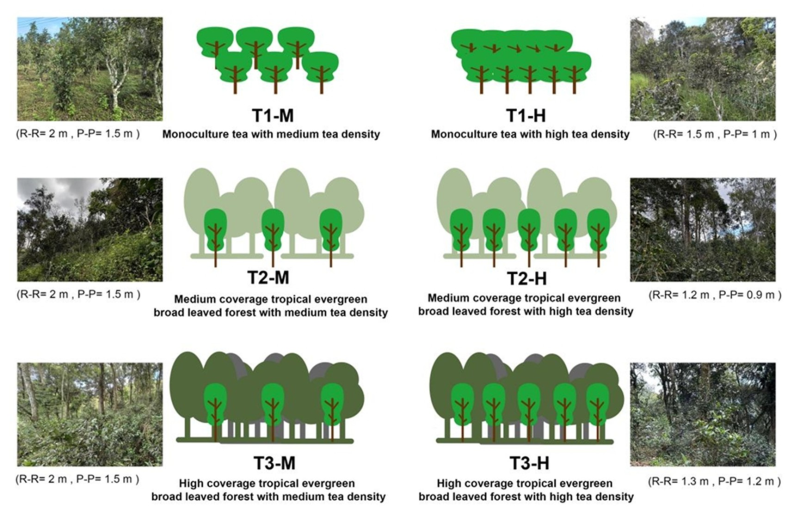
Schematic diagram of experimental design
The ecological environment and planting density of tea gardens are key factors affecting tea quality, but their synergistic mechanisms remain unclear. To address this, SONG Liang's team from the Xishuangbanna Tropical Botanical Garden, Chinese Academy of Sciences, conducted research in ancient tea gardens of Anle Village, Xiangming Township, Mengla County, Yunnan. They systematically analyzed three habitats—monoculture tea gardens, medium-coverage forest tea gardens, and high-coverage forest tea gardens—combined with medium- and high-density planting models to evaluate their impact on tea quality.
Through microclimate monitoring, soil nutrient analysis, and tea metabolite profiling, the study revealed that the "medium-coverage forest tea garden + medium-density planting" model effectively improved the microclimate (e.g., temperature, humidity, light) and enhanced soil nutrient levels. Under this model, the content of catechins—key quality components in spring tea—increased by 50% compared to traditional high-density monoculture plantations. Structural equation modeling further demonstrated that habitat and density primarily regulate the synthesis of tea quality components indirectly through the cascading effects of "microclimate → soil nutrients."
The study elucidated the ecological mechanisms for enhancing tea quality and proposed that the "medium-coverage + medium-density" approach is an optimized cultivation model balancing superior tea quality and ecological sustainability. Thus, it provides critical references for ecological restoration of degraded tea gardens and scientific management of traditional ancient tea plantations.
5. Astronomy & Astrophysics丨Cosmic Cradles on the Edge: Probing Star Formation Mysteries in Metal-Deficient Regions
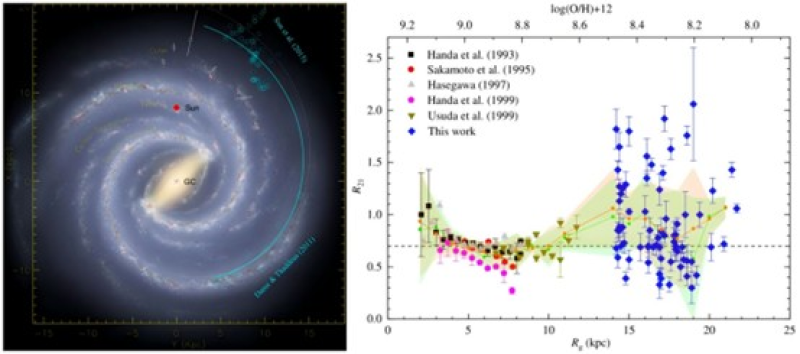
Left: Distribution of molecular clouds (cyan circles) in Galactic outskirts. Right: Variation of R21 ratio with Galactocentric distance.
The outskirts of the Milky Way, characterized by low metallicity and simple star formation histories, serve as natural laboratories for studying molecular cloud evolution and star formation in metal-poor environments. However, due to their large distances, diffuse distribution, and low stellar activity, observational studies of these molecular clouds remain challenging, leaving their fundamental physical properties and formation mechanisms poorly understood.
Researchers from the Xinjiang Astronomical Observatory of the Chinese Academy of Sciences utilized the Spanish IRAM 30-meter radio telescope to observe a sample of molecular clouds located at galactocentric distances of 14–22 kiloparsecs in the outskirts of the Milky Way. Combined with CO(1-0) data from the Purple Mountain Observatory's "Milky Way Imaging Scroll Painting" (MWISP) survey, they conducted a systematic study on the variation patterns of the CO(2-1)-to-CO(1-0) spectral line intensity ratio (R21 ratio) in this region
The study reveals that molecular clouds in the Galactic outskirts exhibit a significantly higher average R21 ratio compared to those in the inner Milky Way and nearby molecular clouds—consistent with trends observed in metal-poor galaxies. Notably, R21 displays a highly scattered spatial distribution. Statistical analyses further demonstrate that regions with elevated R21 ratios spatially correlate with dense molecular cloud cores and low-intensity star-forming activity.
This study has revealed, for the first time, elevated R₂₁ ratios in the Galactic outskirts, providing critical observational constraints that have advanced our understanding of molecular gas excitation mechanisms and star formation processes in low-metallicity environments. These findings have contributed significantly to refining theoretical models of galactic evolution and stellar birth under extreme conditions.